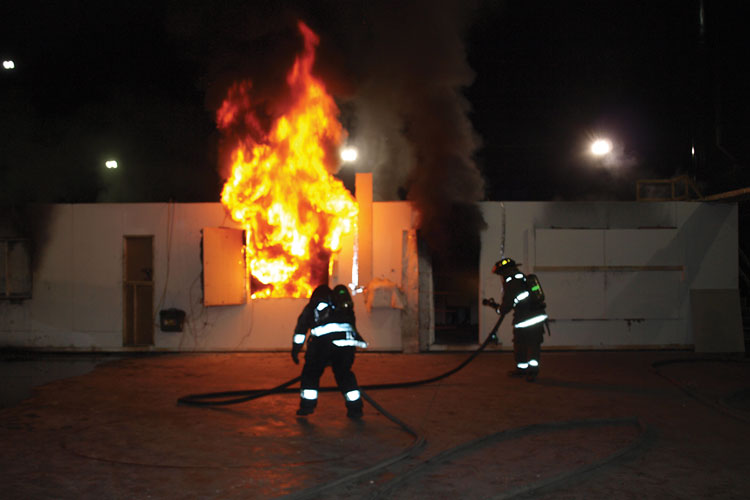
By Jerry Knapp and William Quinn
House fires are our most important alarm. They account for about 75 percent of all structure fires and an equal percent of civilian deaths and injuries. The National Fire Protection Association calculates that the dollar loss from residential fires in the United States is $200 every second, for an annual loss of about $8 billion annually. On average, one American dies in a residential fire every three hours.
In this article, we share what we learned about house fires while observing the live burns at the Underwriters Laboratories (UL) Research Center in Northbrook, Illinois, March 13-15, 2016, and provide insight into how valuable the results of these studies will be in improving strategy, tactics, and firefighter safety when fighting fires in modern houses.
We (Knapp as a member of the technical panel and Quinn as a visitor) witnessed five of the 25 live burns in the “Study of the Impact of Fire Attack Utilizing Interior and Exterior Streams on Firefighter Safety and Occupant Survival” project. This $1.5-million project was funded by a Department of Homeland Security Fire Prevention and Safety, Research and Development Grant.
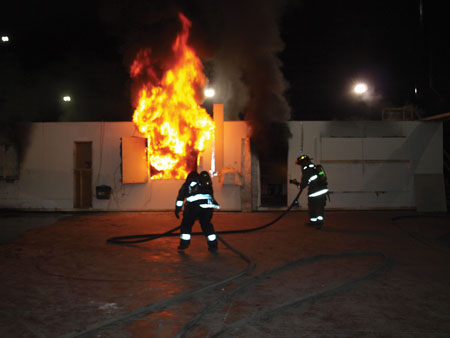 |
| (1) A typical live burn. (Photos by authors unless otherwise noted.) |
Technical Panel Role
The technical panel guides the researchers to ensure that the home layout, fire and suppression scenarios, nozzle techniques, and any variables of the study are applicable to real-world firefighting. The panel included 25 members from across the United States ranging from the largest career departments [the Fire Department of New York and the Los Angeles County (CA) Fire Department]; to average suburban departments (Rockland County, New York); to smaller career departments (Las Cruces, New Mexico); and even to small rural volunteer departments [the Sedgwick County (KS) Fire District]. Additionally, four international members-from Canada, Australia, Belgium, and Ireland-were on the panel.
The researchers presented their plan for the study, 25 live burns, and data collection at the initial meeting in May 2015. The day-long discussions included how to ensure that the burns would mimic the real world and yield valuable data and applicable conclusions relative to fire suppression methods and victim survival. Technical panel members also stressed the need for instrumented live burns in acquired structures to increase acceptance by the fire service and to ensure the applicability of the data collected from the laboratory burns and the subsequent conclusions.
The researchers updated their plans and presented them to the technical panel for review and comment, resulting in the final matrix of live burn scenarios and goals. As noted, this collaboration was designed to provide realistic scenarios for victim and firefighter survival and to evaluate various fire attack/nozzle team methods.
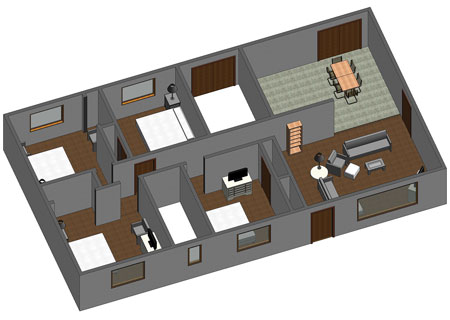 |
| (2) A 3-D rendering of the test house. (Photo courtesy of Underwriters Laboratories.) |
House Fire Conditions
As the world-class fire researcher Stefan Svensson has stated, “The fire simply follows the conditions given, whether we know them or not.”1 This sentence is the classic tip of the iceberg that will lead the next generation of firefighters to safer, more effective strategy and tactics for house fires. UL is measuring and evaluating these conditions at house fires and ensuring firefighters know what they are so we can review, modernize, and adjust our strategies and tactics as necessary.
Red Devil
Traditionally, we call fire by emotion-laden names: the Red Devil, the Dragon, the Beast-and justly so. We have seen “IT” kill and injure firefighters and civilians, especially babies and the elderly, without mercy. In 1999, we saw fire burn two firefighters to death at a house fire on Cherry Road in Washington, D.C.2 This fire signaled a new era of fire dynamics and firefighting in modern house fires. Fire Protection Engineer Dan Madrzykowski, then with the National Institute of Standards and Technology (NIST), studied this fire. The firefighters attacking this fire were correctly applying the strategy and tactics they were taught and had practiced. In the end, they had no time to open the nozzle of the charged hoselines in their hands; the fire traveled up from the basement so fast. They died on the first floor of a typical row house, the kind of fire that takes place in almost every community in America, the kind of fire you could go to on your next shift.
Fire Experience
Based on our fireground experience, we draw conclusions from what we see, feel, and observe on the fireground. As a subscriber to Fire Engineering, you are obviously a student of fire protection. You have a burning desire to understand fire behavior, building construction, fire attack methods, ventilation, search and rescue operations, and so on, so you can be more effective when the bells ring for your next house fire. There is no calling that is higher, nobler, or more challenging. We call it “the Job,” but we all know it really is “the Life”; and for many of us, it ends too soon, often in painful, career-ending ways on the fireground.
So in a well-intentioned effort to improve and protect ourselves, other members, and our profession, we evaluate what “went wrong” at fires like Cherry Road (the list of similar fatal house fires is long and repetitive). We read National Institute for Occupational Safety and Health reports and departmental investigations to try to filter out the life-saving tactical gems we can take to our next fire to improve our operations, protect our members, and better serve the public.
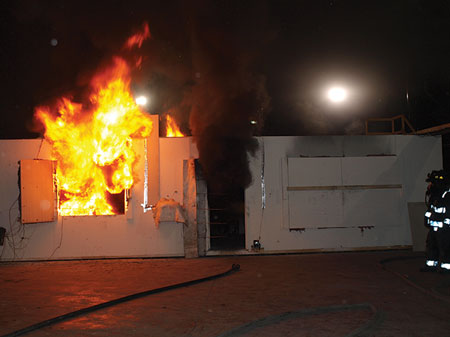 |
| (3) The fire was allowed to go to flashover. |
Similarly, linking the report findings to our own fireground experiences and department, we logically and naturally want to draw conclusions to reinforce, modify, or improve our strategy and tactics. Since this is all we have to draw from, it is logical and, on the surface, appears to be a productive and positive, proactive approach.
As time and careers progress, leaders develop in the fire service and the strategy and tactics we developed over time are taught (handed down) in probie and recruit classes. Strategies and tactics are taught at officer and firefighter levels and are applied daily. Sporadically across the nation, a devastating fire occurs, firefighters are injured or killed, and funerals and memorials are executed with military precision. Of course, the required reports are filed as lessons learned for fire service consumption. The result of this process is that our strategy and tactics for house fires are based on our limited observations of conditions on the fireground. In fact, our fireground observations are not the conditions at all. What we experience and observe on the fireground is the result of the conditions the fire has to work with to produce or not produce flashovers and other deadly conditions.
We treasure our fireground experience, talk about it often, and become experienced firefighters. The data from our fireground experience are very limited, just as our visibility in a smoke condition. But, is our experience just something we got away with? Were we lucky to have had positive outcomes?
UL Historic Data
Although there has been a variety of scientific engineering studies on fire, fire development, fire suppression methods, and so on, no studies have been more valuable to the American fire service than the recent UL studies.
What makes these studies most useful to the fire service is their direct applicability to our strategy and tactics. The studies provide an understanding of what the fire is doing or not doing (based on conditions) and how our search, hoseline, and ventilation tactics affect overall victim survival; firefighter safety; fire suppression (conditions); and, therefore, effectiveness.
Let’s put it another way: This is historic research done in a manner that allows firefighters to understand the modern house fire, record the fire conditions, and evaluate how those conditions (oxygen supply, pressure, and fuel, for example) make the fire behave. On the fireground, we can see the result of these conditions (fireground experience) but not what is causing the fire’s next action. Equally important is that the most recent study enables us to measure the effect of our operations (fire suppression) on victims and the fire.
The landmark, ground-breaking, historical change for the fire service here is this: We now have data to evaluate how and why the fire developed the way it did, how it was suppressed sooner or later, whether victims died or survived, and whether flashover occurred instead of just observing the effect or result of conditions (flashover, for example) and remain blind to the real-world causes of the condition changes.
 |
| (4) Researchers direct a stream into the involved room from the outside. |
The data from the test fires we observed are the “conditions given,” which Svensson referred to in his above quote. The data collection is specifically tied to realistic fireground conditions such as which doors and windows are open, how much air is available to the fire, and typical home construction and furnishings, for example. The most recent study monitors and evaluates conditions that are changed or created as a result of typical fire attack scenarios-in essence, exactly what we will face in a real-world fire situation. These live burns and the data collected are the beginning of a new understanding of house fires.
Is fire suppression scientific? There is little science involved in hauling a 1¾-inch hoseline discharging 180 gallons per minute into a burning house while wearing 80 pounds of personal protective equipment and working in near-zero visibility conditions. What are scientific are the chemical reactions driving the fire growth. What we need to know and understand are the conditions that affect fire development and how we change those conditions through search, ventilation, and fire attack operations.
We are not sure scientific is the right word to describe conditions in a house fire. “Facts” or “data” may be better choices. For example, what were the temperature and oxygen content in the adjacent rooms at your last fire? What is clear is that for firefighters, and especially fire officers, to be effective on the fireground, they must understand-and not only by looking at the result (what we see on the fireground and our limited visibility in smoky conditions)-the process of fire development (fire dynamics) and how our operations affect it. Additionally, we must have the understanding that will enable us to choose and modify fire tactics and strategies on the fly. This is especially true at house fires (the focus of this study) because of the huge life and dollar losses and injuries of civilians and firefighters. Up to this point in the development of strategy and tactics for modern house fires, the American fire service has relied solely on fireground experience (the end result).
Lessons Learned
Undoubtedly, the most important fact we learned from observing these live burns is that the fire is going to do what the conditions provide for, not what we think based on our fireground experience. We saw this repeatedly while watching the studies.
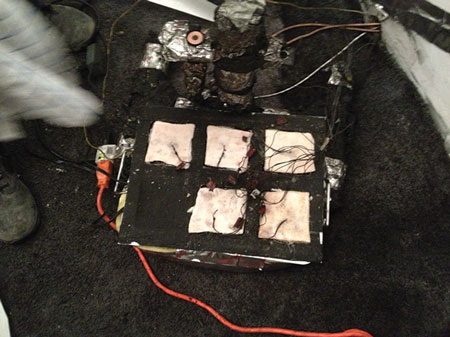 |
| (5) A victim package with temperature and moisture sensors. |
In the live burn in photo 3, a fire was ignited in the bedroom and allowed to develop to flashover. The door was opened and vented heavy smoke from the top and allowed fresh air in the bottom-a bidirectional flow path. We all expected the fire to extend into the furnished living room. A flood light could be seen illuminated in the living room with the smoke about three or four feet off the floor. Researchers then directed a straight stream from a combination nozzle into the fire room from the outside (photo 4). Visibility remained good in the living room and appeared to be survivable for both civilians and firefighters. We could not see any push of fire or products of combustion into the living room.
Robin Zevotek, lead engineer with the UL Firefighter Safety Research Institute, explains: “From a quick look at the data, although you didn’t have visual flames down the hallway, you had temperatures/heat flux and gas concentrations that would result in injuries/fatalities to occupants. In several cases, no flames were observed, but temperatures were hot enough to potentially cause injuries to firefighters in full protective clothing.” What we see and what we assume the conditions to be may not necessarily be correct.
Data Collection
Measurements of conditions inside the test home were as impressive as they were massive. Each live burn was instrumented to measure critical parameters in every room: temperature; concentrations of oxygen (O2), carbon monoxide (CO), and carbon dioxide (CO2); pressure; and velocity. They were also documented visually and by thermal imaging. In the words of the study proposal, “These measurements will allow for quantification of fire behavior, the impact of the water application, and tenability for firefighters and occupants. Five victim measurement packages were placed in the test fixture. The packages consisted of temperature measurements at multiple elevations; gas concentration measurements (O2, CO, CO2); and heat flux with water conditioned to 98°F to get more accurate heat transfer to skin; instrumented pig skin samples; a laser-based moisture measurement device; and a video camera.”
Zevotek revealed that from each burn there are about 300 megabytes (mb) of data and 40 gigabytes (gb) of video. These data equated to 235 columns and 77,000 lines of data-certainly much more than we can “collect” while inside searching or extinguishing a house fire.
Victim Packages
It is great to collect data about the fire conditions, but life safety-ours and the trapped civilians-is our first priority. The real-world practicality of including a method to determine if a victim is burned to death, survives with burns, or is suffocated or incapacitated by deadly smoke or a lack of O2 is a facet of the study of immeasurable value to firefighters. Adding further value to this portion of the study is that the measurement of conditions continues during the fire attack to determine positive and negative effects of hoseline placement on victim survival and firefighter safety.
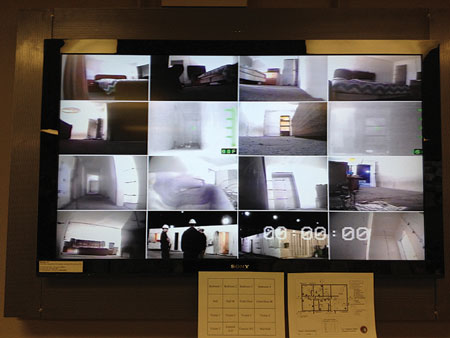 |
| (6) A unique opportunity: 16 views including a thermal imaging view of a fire from start to finish. |
Steam
There is an ongoing conceptual battle in the fire service about the negative impact on victims of the steam created by an interior fire attack. Frankly, there is a lot of talk but few facts about this topic. The victim packages included a state-of-the-art moisture measurement instrument that provides data to determine if the moisture caused by the hoseline has any effect on victim survival. We have all experienced “being steamed” during a fire attack or search operation. Consider this: If our skin burns at about 130°F, could we really tell if we were driven out or burned by the 130°F steam, the 1,000°F steam, or the existing fire heat that took time to penetrate the insulation value of our gear? How saturated with heat was our gear before we “got steamed”?
The technical panel members and the 75 visitors witnessing these tests were very impressed by the overall concept of the instrumented live burns and their potential effect on the future development or modification of fire attack strategy and tactics at house fires. There was so much more to observe than the evaluation of the live burns. The gap between this history-making world-class research and the tactics and strategy we use in our home departments left many in attendance almost speechless.
Watching
Sixteen views, including thermal imaging and digital video, of each burn were fed into the observation room and at the control station for the experiments. It was a rare opportunity to view the fire from this many perspectives! Firefighters consider it a success when we conduct a 360° walk-around of the building and size up what the fire is doing on the inside. During the experiments, we saw the fire from inside each of the rooms, from the hallway, and from open and closed rooms. We saw the thermal imaging views and even the exterior view of the rear of the house.
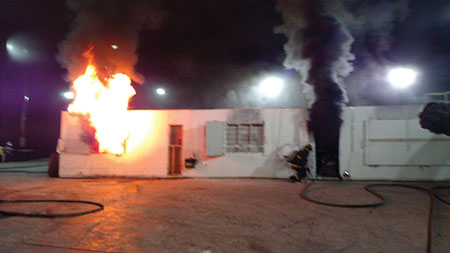 |
| (7) The researcher prepares to advance a 30° fog stream. |
This leads to another important lesson learned: It takes even the best trained firefighter a lot of time to understand and digest this massive body of work. The reports are lengthy, but they are well worth the time in that you get to truly understand all the information gained from the live burns and other supporting testing and measurements. The goal, of course, is to make it useful to you on the fireground. The summary and conclusions from all these data are difficult to embrace without understanding the complete background data. This is especially true if the conclusion recommends a change in current tactics. It is not fun, and often is almost painful, to try to understand the mountain of data in the final reports. It is, however, essential to increasing our fireground survival rate and decreasing our fireground death rate at house fires.
Gas Cooling
We engaged in extended discussions with panel members Hans Hazebroek, a senior fire researcher from the Netherlands, and Steve Brisebois, a captain from the Montreal (Canada) Fire Department and a principal of the firm Flash Formation, which teaches fire dynamics. Among the topics was the “European method” of fire attack in which gas cooling is a major factor in the advancing of interior hoselines. Using short bursts of a narrow fog pattern pointed at the ceiling cools and contracts the fire gases and improves visibility so the attack team can penetrate to the seat of the fire for a direct fire attack. Of course, this method was met with a fair degree of skepticism from American colleges, but it appears to be a viable method that is worth investigating.
Air Entrainment
In 2004, instructors Jerry Knapp, Chris Flatley, and Tim Pillsworth of the Rockland County (NY) Fire Training Center measured air entrainment caused by solid and broken fog and straight streams from combination nozzles. Measurement of hose stream air entrainment is critical to the development and suppression of the house fire because we now know that the amount of air the fire is given often determines whether it will grow to flashover.
Flashover is an especially vicious killer of firefighters at residential fires. In one study, solid and straight streams off combination nozzles were found to move approximately the same amount of air (about 750 cubic feet) in contrast with fog nozzles, which moved thousands of cubic feet of air.3,4
In this study, UL continued to measure air entrainment and its effect on house fires and found that a straight stream from a combination nozzle (150 gpm @ 50 psi) would entrain about 1,000 cubic feet and a solid bore nozzle (150 gpm @ 50 psi) about 500 cubic feet.
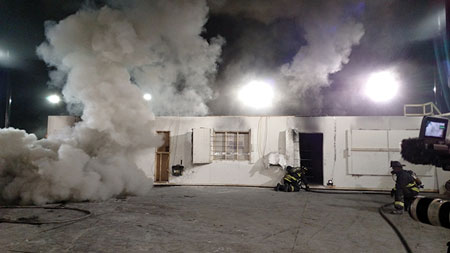 |
| (8) A fog stream pushes large amounts of smoke during the attack. |
According to UL researchers Zevotek and Keith Stakes, “When the nozzles were held steady, they both entrained air. The smooth bore entrained less air, but relatively the same magnitude. When the same nozzles were used with a pattern such as ‘O,’ ‘Z,’ or ‘N,’ the air entrainment increased by a factor of more than five times and may be as high as 6,000 to 7,000 cubic feet of air per minute. The type of pattern chosen made a minimal difference.”
One of the live burns we observed showed the disastrous effects of huge volumes of air entrained by fog nozzles when used for interior fire attack. The demonstration used a 30° fog nozzle in the fire attack. Even from our observation from the outside without access to any of the data, it was clear that using a fog nozzle on a house fire in a traditional North American manner will push smoke and other products of combustion in a robust manner. The UL study contains data on pressure and volumes of air moved, which will provide some valuable insight into this method of residential fire attack and its effect on occupant and firefighter safety.
To reiterate the importance of this study in putting numbers on our suspicions and beliefs, the Rockland instructors measured 2,000 cubic feet per minute (cfm) of entrained air in fog nozzles and estimated between 6,000 and 10,000 cfm were moved by 1¾-inch fog streams. Interestingly in 1974, William Clark had previously stated similar estimated numbers in Firefighting Principles and Practices. This book was a cornerstone for strategy and tactical development for fire officers across our nation for years. Now, as a result of the air-entrainment portion of the UL study, the American fire service has real hard and actual reliable measurements for the amount of air the nozzle injected into a fire.
The Future
Every chief, officer, and firefighter should be aware of this research and the lessons that are learned or reinforced with the backing of new scientifically measured data. Several long-held fire service myths have been disproven while other experienced-based tactics have been proven to be effective. Several tactical considerations and recommendations have also been suggested.
What will the fire service do with all this information? Hopefully, we will make better decisions based on the findings and add our experience and other training with the result of saving firefighter and civilian lives. Fires are down, and so is our collective experience. The research can assist officers and firefighters who are improving or developing their department procedures. We can base our actions and tactics on knowledge, not just skills and abilities that have been passed down from generation to generation-in some cases, with no basis in fact or reason.
This information is “another tool in our toolbox.” We have many tools on our rigs, but we don’t use all of them at every fire or emergency. Success on the fireground is based on knowledge, training, and experience. Many very knowledgeable firefighters have commented on and looked at this research with an uncertain eye, disbelief, or skepticism. We rely on gauges, meters, and thermal imaging cameras (TICs) for many aspects of our job. Why would we not rely on the meters, gauges, or TICs used in the studies?
The critical question is, how do we use this new information in a controlled and practical manner to improve operations at house fires? The biggest mistakes we can make are to ignore our experience with successful search, ventilation, and fire attack methods and to immediately adopt new fire attack techniques and apply them at every working fire.
The fire service and the safety and loss control industry have relied on UL testing and information for many years. Dr. Neil deGrasse Tyson, an astrophysicist with the Hayden Planetarium in New York, is quoted as saying, “The good thing about science is that it’s true whether you believe in it or not.” It could be said that this quote applies here.
We urge you to seek out the information for yourself, your department, and the people you serve. Numerous Web sites and online videos are available. You may also obtain information from A.L.I.V.E. (Advanced Learning through Integrated Visual Environments) training, which is used in Fire Department of New York firehouses, www.engineering.nyu.edu/fire/alive.
Other Web sites for free self-paced training include the following:
Thanks to the UL Firefighter Safety Research Institute for technical assistance with this article.
References
1. Svensson, Stefan, There is No Such Thing as Extreme Fire Behavior, Fire Engineering, March 2015, 169.
2. Knapp, Pillsworth, and White, “Nozzle Test Prove Fireground Realities, Part 1”; Fire Engineering, Feb. 2003.
3. Knapp, Pillsworth, and Flatley, “Nozzle Test Prove Fireground Realities, Part 2”; Fire Engineering, Sept. 2003.
4. “Nozzle Test Prove Fireground Realities, Part 3”; Fire Engineering. Feb. 2004.
5. Clark, William. Firefighting Principles and Practices, 2nd ed. Fire Engineering Books and Videos; 1991.
JERRY KNAPP, is a 39-year veteran firefighter/EMT with the West Haverstraw (NY) Fire Department and a training officer at the Rockland County Fire Training Center in Pomona, New York. He is a member of the technical panel for the Underwriters Laboratories research on interior and exterior fire attack at residential fires. He is the chief of the Rockland County (NY) Hazmat Task Force and a former nationally certified paramedic. He has a degree in fire protection and is an adjunct professor of fire technology. He authored the Fire Attack chapter in Fire Engineering’s Handbook for Firefighter I and II and has had numerous articles published in Fire Engineering.
WILLIAM QUINN, a 41-year veteran of the fire service, is a firefighter with the Westwood (NJ) Fire Department. He is a fire instructor with the Bergenfield (NJ) Fire Training Center and an associate member of the Bergen County Fire Chiefs Association, a member of the Bergen County Fire Academy Advisory Board, and a member of the International Society of Fire Service Instructors. He is New Jersey Division of Fire Safety certified as Fire Instructor II, Fire Inspector/Fire Official, Fire Officer II, and Incident Management Level III and is a National Fire Academy National Juvenile Fire Setter Intervention Specialist II. He studied in the fire science program at New Jersey City University.
Modern House Fires Warrant Tactical Agility
House Fires: New Threats, New Tactics
MORE ON THE MEANING OF STRATEGY AND TACTICS
Fire Engineering Archives

